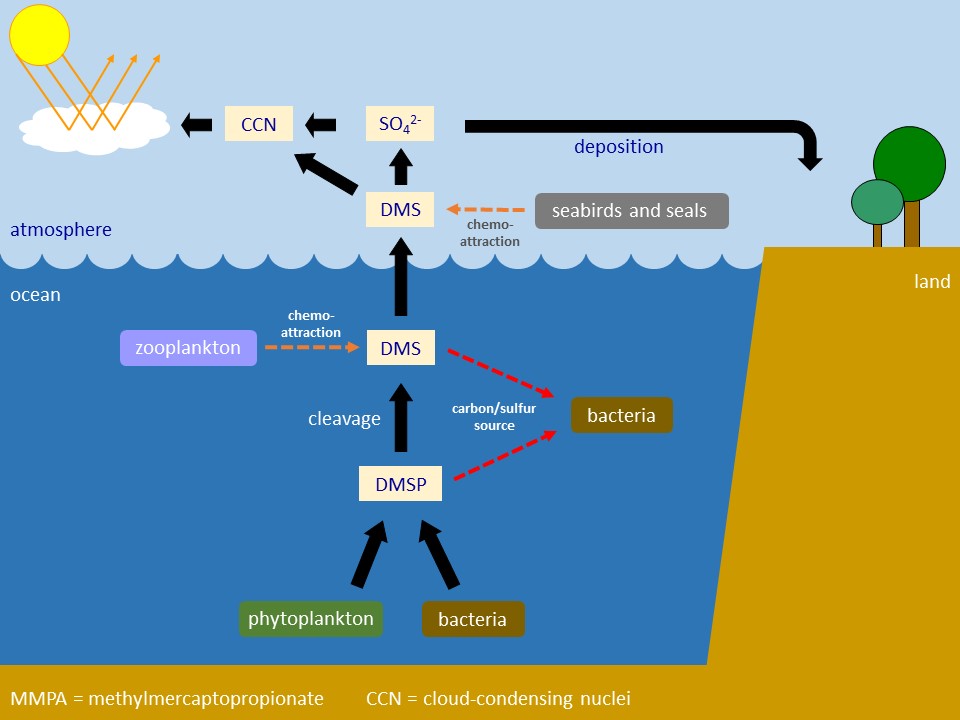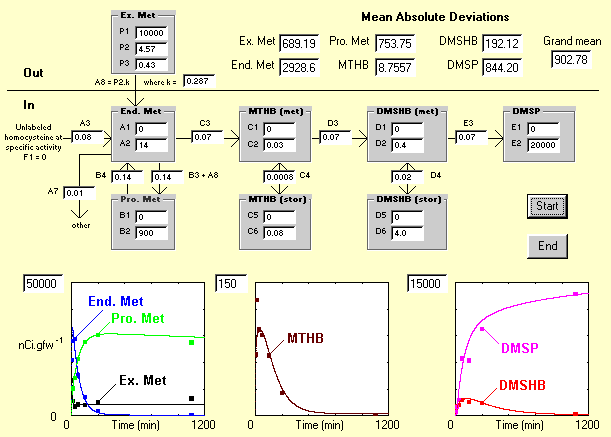A recent news article in Nature Microbiology (Curson, A. DMSP synthesis in phytoplankton unravelled (2018): https://naturemicrobiologycommunity.nature.com/users/84434-andrew-curson/posts/30656-dmsp-synthesis-in-phytoplankton-unravelled) includes the following informative image describing the role of the compound dimethylsulfoniopropionate (DMSP) in the ocean environment:

Roles of DMSP and DMS in the environment (Curson, 2018)
DMSP is produced by many marine organisms (phytoplankton (minute marine algae), seaweeds, corals and many marine bacteria). DMSP is thought to play a critical role in osmotic adjustment in these marine organisms, protecting the cytoplasm of their cells against the adverse effects of the high extracellular salt concentrations of the sea water. DMSP has also been proposed to be an antioxidant and cryoprotectant as it is found at particularly high levels in algae that thrive in icy ocean waters (ice algae). DMSP is very labile and under alkaline conditions it will degrade spontaneously to the sulfur gas, dimethylsulfide (DMS), at room temperature. Marine bacteria possess an enzyme that catalyzes (and thus accelerates) this same reaction. So when DMSP is released from dying marine organisms (e.g. dying algal blooms) both spontaneous degradation of DMSP, and bacteria-mediated degradation of DMSP to DMS occurs. DMS is then released to the atmosphere and is responsible for the smell of the ocean, or, as Curson (2018) states: "DMS is sometimes referred to as the ‘smell of the seaside’ for the fact that this highly odorous gas is a major part of the smell we encounter when we visit the beach, but importantly it is also detectable by animals, such as seabirds and seals, which may use it to locate their food."
When DMSP degrades to DMS, it leaves behind a toxic molecule, acrylate. It has been suggested that acrylate may play a role as a predator or herbivore deterrent or anti-feedant.
DMS is released in vast quantities from the ocean, playing a major role in the global sulfur cycle. Moreover, DMS is a cloud-condensation nucleus. Thus, dying algal blooms can often generate clouds (Curson, 2018).
I was fortunate to work with a group of scientists led by Andrew D. Hanson in the mid-1990's to identify the metabolic pathway of DMSP biosynthesis in marine algae. Our group established that methionine was the precursor of DMSP by the following pathway:

Gage, D.A., Rhodes, D., Nolte, K.D., Hicks, W.A,, Leustek, T., Cooper, A.J., Hanson, A.D. A new route for synthesis of dimethylsulphoniopropionate in marine algae. Nature 387 (6636): 891-894 (1997) https://www.nature.com/articles/43160
The seaweed *Enteromorpha intestinalis* was fed with radioactive methionine labeled in the sulfur moiety with the isotope sulfur-35. Samples were taken over a time-course and the amount of radioactivity in various metabolites and protein was measured. Results were then simulated using Visual Basic, progessively adjusting assumptions about methionine uptake rate, compartmentation of metabolite pools, and rates of synthesis of intermediates and end-products (protein-bound methionine and DMSP) until the best fit to the observed data was obtained (i.e. until mean absolute deviations between observed and simulated data were minimized):

(Preceding two images from: A.D. Hanson, D.A. Gage, K.D. Nolte, W.A. Hicks, T. Leustek, A.J. Cooper, A. Nadolska-Orczyk, S. Islam, P.J. Rich, D. Rhodes. Computer Simulation of Metabolism: Simulation of The Pathway of DMSP Biosynthesis in *Enteromorpha intestinalis* (2003) https://hort.purdue.edu/CFPESP/Models/mo00006.htm)
A version of this simulation model (with 4 re-sizeable frames) written in Javascript is available on the web, simulating results in tabular form rather than graphical form:
Rhodes, D. DMSP Radiolabeling Kinetics Simulator (2003) https://hort.purdue.edu/CFPESP/Models/jvsdmsp/jvsdmsp.htm
(note: this web-based simulation model still works in the Chrome browser, but I can't guarantee that it functions in other browsers!)
This pathway of biosynthesis of DMSP has now been confirmed to operate in marine bacteria:
Curson, A.R., Liu, J., Bermejo Martínez, A., Green, R.T., Chan, Y., Carrión, O., Williams, B.T., Zhang, S.H., Yang, G.P., Bulman Page, P.C., Zhang, X.H., Todd, J.D. Dimethylsulfoniopropionate biosynthesis in marine bacteria and identification of the key gene in this process. Nat. Microbiol. 2: 17009 (2017)
https://www.nature.com/articles/nmicrobiol20179
and in marine phytoplankton:
Bullock, H.A., Luo, H., Whitman, W.B. Evolution of dimethylsulfoniopropionate metabolism in marine phytoplankton and bacteria. Front. Microbiol. 8: 637 (2017)
https://www.frontiersin.org/articles/10.3389/fmicb.2017.00637/full
Curson, A.R.J., Williams, B.T., Pinchbeck, B.J., Sims, L.P., Martínez, A.B., Rivera, P.P.L., Kumaresan, D., Mercadé, E., Spurgin, L.G., Carrión, O., Moxon, S., Cattolico, R.A., Kuzhiumparambil, U., Guagliardo, P., Clode, P.L., Raina, J.B., Todd, J.D. DSYB catalyses the key step of dimethylsulfoniopropionate biosynthesis in many phytoplankton. Nat. Microbiol. doi: 10.1038/s41564-018-0119-5 [Epub ahead of print] (2018) https://www.nature.com/articles/s41564-018-0119-5
A particularly important finding from the latter, very recent paper (and the subject of the news article by Curson mentioned at the top of this post) is that a key gene in the pathway has now been identified that encodes the enzyme that catalyzes the conversion of MTHB to DMSHB, an MTHB methyltransferase. This enzyme may be the rate-limiting and committing step in the DMSP synthesis. Surprisingly, evolutionary analysis suggests that the algal (eukaryotic) gene (designated DSYB) encoding this enzyme first originated in bacteria and was passed to eukaryotes early in their evolution.
Not all eukaryotes have the same pathway of DMSP synthesis, however. In angiosperms (flowering plants) two additional pathways of synthesis of DMSP have been identified, and this will be the subject of my next post.